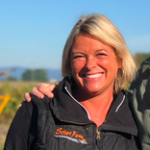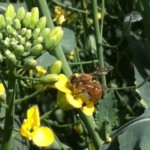 The 2016 canola harvest has all but wrapped up in Oregon’s Willamette Valley and it was another good year – fields averaged 3,000 pounds per acre and one grower exceeded 5,000 pounds per acre. But more importantly, it was another year of successful rotational crops for Willamette Valley farmers.
The 2016 canola harvest has all but wrapped up in Oregon’s Willamette Valley and it was another good year – fields averaged 3,000 pounds per acre and one grower exceeded 5,000 pounds per acre. But more importantly, it was another year of successful rotational crops for Willamette Valley farmers.
Agronomy
More Washington State Growers Choose Canola, Seek Advice on Blackleg
 Interest in canola as a rotation crop in the cereal-dominated cropping systems of the Pacific Northwest continues to increase, particularly with depressed wheat prices, and with steady demand from the Pacific Coast Canola processing facility in Warden, Wash. The Crucifer Quarantine enacted last fall, however, has prompted many questions and requests for advice about blackleg from growers and industry. In response to concerns, faculty at the Washington State University-based Washington Oilseed Cropping Systems Project developed a handout to distribute at field tours. The guide includes concise information about the current status of blackleg in Washington, the Crucifer Quarantine requirements, scouting for blackleg, and photos of blackleg symptoms from fields in Idaho and Oregon.
Interest in canola as a rotation crop in the cereal-dominated cropping systems of the Pacific Northwest continues to increase, particularly with depressed wheat prices, and with steady demand from the Pacific Coast Canola processing facility in Warden, Wash. The Crucifer Quarantine enacted last fall, however, has prompted many questions and requests for advice about blackleg from growers and industry. In response to concerns, faculty at the Washington State University-based Washington Oilseed Cropping Systems Project developed a handout to distribute at field tours. The guide includes concise information about the current status of blackleg in Washington, the Crucifer Quarantine requirements, scouting for blackleg, and photos of blackleg symptoms from fields in Idaho and Oregon.
Science Meets Art: In Praise of Modern Plant Breeding
 Over the last several thousand years, humans have taken a more active role in the evolution of plants by specifically saving and selecting seed from plants that looked, smelled or tasted particularly interesting. The result was the domestication of plants, making it easier to grow and harvest them and become better, more reliable and nutritious sources of food. This same process continues today, though in a more formalized way, using the science and art of plant breeding.
Over the last several thousand years, humans have taken a more active role in the evolution of plants by specifically saving and selecting seed from plants that looked, smelled or tasted particularly interesting. The result was the domestication of plants, making it easier to grow and harvest them and become better, more reliable and nutritious sources of food. This same process continues today, though in a more formalized way, using the science and art of plant breeding.
NCGA’s 2016 Canola Research Focuses on Disease

Canola research is more important than ever to the crop’s future. With this in mind, the Northern Canola Growers Association (NCGA) has awarded $220,000 so far in 2016 to help fund nine studies. Projects this year address disease identification and control in canola, primarily blackleg and sclerotinia. Additional research seeks to decrease production costs, increase quality of canola and identify end-use applications.
Working with the ‘Girls:’ Honey Bees and Hybrid Canola Production
 Pretend for a moment it is an early afternoon in the middle of July in Colorado’s San Luis Valley. I’m on my way to visit the honey bee “girls” in the field. They have been staying with us now for over two weeks and have settled into a predictable routine.
Pretend for a moment it is an early afternoon in the middle of July in Colorado’s San Luis Valley. I’m on my way to visit the honey bee “girls” in the field. They have been staying with us now for over two weeks and have settled into a predictable routine.